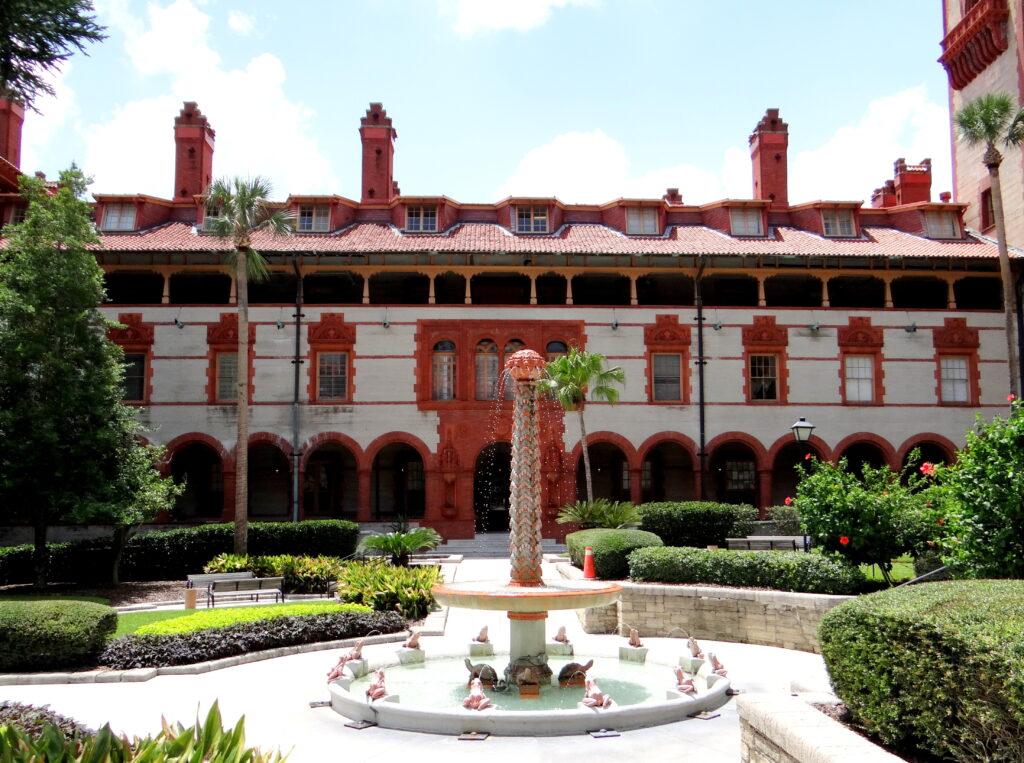St. Augustine Part 2 – Henry Flagler and The Ponce
Henry Morrison Flagler was born in New York on January 2, 1830. Intelligent and industrious, Flagler was known for using his ingenuity and abilities to turn endeavors into thriving entrepreneurial success stories. At just 14, and with only an eighth-grade education, he began a very profitable career in his cousin’s family grain business. At age 23, he married Mary Harkness and the couple eventually became parents of two daughters and one son.
Over the years he lost and rebuilt his fortunes several times. Branching out in a different direction, he went into the salt mining and production business with his brother-in-law. When that business failed, he returned to the grain industry and rejoined the Harkness Grain Company. Then in 1870, he partnered with John D. Rockefeller and John Samuels of the Standard Oil Company. This was a highly lucrative move for Flagler. His wealth continued to increase and the family enjoyed living a life of luxury on desirable Fifth Avenue in New York City.
Unfortunately, Mary’s health was declining. In 1878 they first visited Jacksonville so Mary could benefit from Florida’s warm sunshine. Sadly over the next few years, Mary’s condition continued to deteriorate and she died in 1881 at the age of 47.
Flagler visited Florida once again in 1883, but this time in St. Augustine. Everything about Florida and St. Augustine impressed Flagler, except for what he considered ‘inadequate accommodations and a weak transportation systems’. Being the visionary that he was, Flagler saw clearly that Florida had the potential to draw large numbers of tourists…wealthy tourists from the north. In order to devote his time and resources to his new plans, Flagler gave up his day-to-day involvement in the Standard Oil Corporation, retaining his place on the Board of Directors.
In 1885 with his goal fixed clearly in sight, Flagler began construction on his first of many Florida masterpiece hotels, St. Augustine’s posh 540-room Ponce de Leon Hotel. Understanding the importance of an efficient transportation system to support his hotel ventures, Flagler purchased the Jacksonville, St. Augustine & Halifax Railroad, the first railroad link in what would eventually become the Florida East Coast Railway system.

The “Ponce” as it was called, was built on five acres of land which was part of a former orange grove, designed in the Spanish Renaissance Revival style architecture. Over 60,000 barrels of cement were used on the building with towers that rose 150 feet. Originally, these twin towers contained 80,000-gallon storage tanks providing water for hotel guests. The hotel also was wired for electricity at the onset, with the power being supplied by generators supplied by Flagler’s friend, Thomas Edison. Yes, it helps to know the right people!
In record time, the hotel was finished in May 1887, proudly displaying seventy-five of Louis Comfort Tiffany’s elaborate stained glass windows in the ninety-foot dining room alone and other priceless pieces of art.
On opening day, January 10th, 1888, invited guests arrived on the first sleeper/vestibule train ever to visit St. Augustine. Among the first-night guests were Mrs. Ulysses S. Grant, Frederick Vanderbilt, and William R. Rockefeller. It was dark as they were driven by carriage from the train station to the hotel. They must have been awed by the size of the mammoth four-story building with lights glowing outside and within. Inside the iron gated entrance was a lush landscaped 10,000 square foot courtyard with a large fountain designed like the handle of a sword piercing the ground staking its claim, and surrounded by mini fountains shaped as twelve frogs (for the twelve months) and four turtles, (for the four seasons). A grand arched entrance to the rotunda invited them inside.

The rotunda was used as the lobby of the hotel and gave the first visitors a taste of the over-the-top opulence they were to enjoy during their stay. The lavishly painted gold dome ceiling with cupids, sailing ships, beautiful maidens, and names of explorers, rises eighty-six feet above the inlaid marble floor. Ornately carved wood caryatids or columns in the shape of cloth-draped female figures gracefully stand supporting the structure.

Lady guests were discouraged at the check-in desk, but were scurried off to the ladies’ parlor adjacent to the rotunda. This luxurious parlor was the most expensive room at the hotel with Tiffany chandeliers and a clock made of the “largest piece of intact white onyx in the western hemisphere”. There the ladies would spend their time listening to music and mingling while the men dealt with the check-in business.

For decades, the rich and famous walked the halls of The Ponce. Lavish galas with guests dressed in their finest being catered to and treated like royalty. Truly the Gilded Age in our history.
Things have changed and since 1968 The Ponce de Leon Hotel has served as Flagler College, a private four-year liberal arts college. However, each day at 10:00 a.m. and 2:00 p.m., Flagler College offers tours of the public spaces of the former Ponce de Leon Hotel. It’s a wonderful experience you will definitely enjoy!
More information and tickets are available at https://legacy.flagler.edu/products/historic-tour-of-flagler-college-former-hotel-ponce-de-leon

Check out the Part 1 of this series https://firstcoast.life/my-color-full-florida-ponce-de-leon-and-his-search-for-the-fountain-of-youth/
- About the Author
- Latest Posts
Linda Schilling Mitchell has spent 99% of her life in Florida. She enjoys warm weather, the sights and sounds of the ocean and anything and everything to do with her family.
After retiring from the Hotel/Hospitality industry, she spent three years writing Florida history articles for a newspaper in south Florida. These articles were the inspiration for her book My Color-Full Florida.
My book “Dear Miss Schneider, Please excuse Walter…” takes place during the Great Depression, and is a tribute to her mother Victoria Schneider who was a third grade teacher during 1937-1940. It gives a personal look at family life during those difficult years.
And Maggie’s World, well that was Maggie’s idea!
My Color-Full Florida
“Dear Miss Schneider, Please excuse Walter…”
Maggie’s World
















One Response
What a wonderfully informative article!
I’ve actually been there and went on the guided tour; it is definitely worth the trip. I learned some new facts while reading this however!
It’s pretty incredible that such rich history is still standing today. It’s absolutely breathtaking to see in person.
Good read!